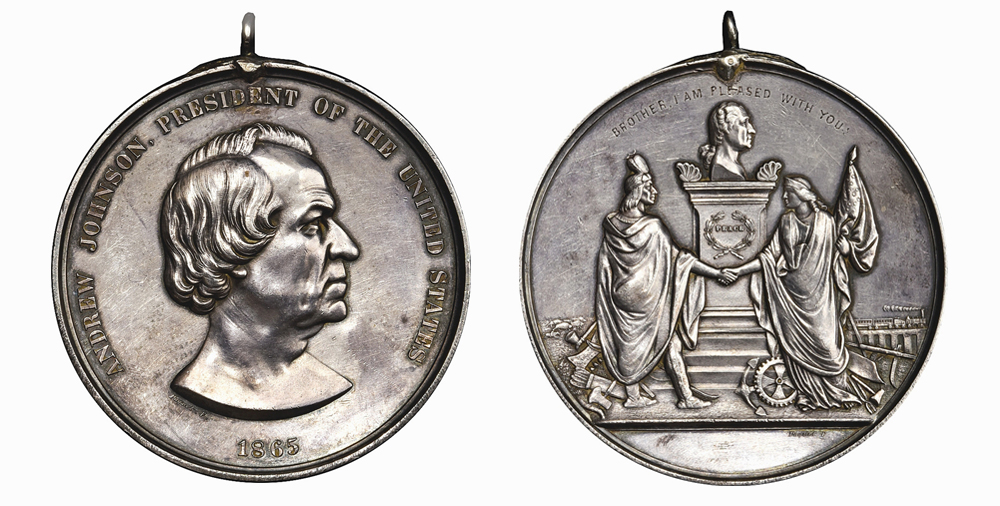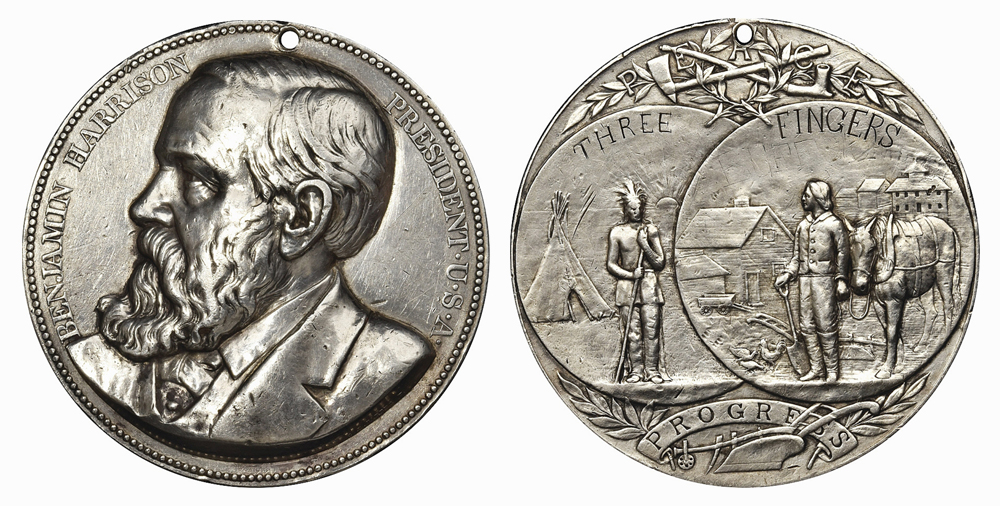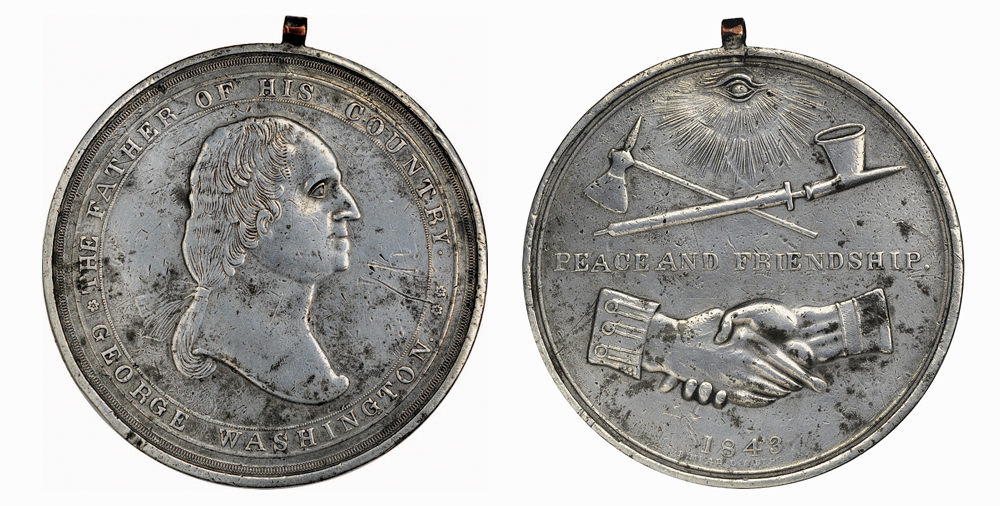
Top lot in the sale was this 1865 Andrew Johnson Indian peace medal, silver, first size, Julian IP-40, Prucha-52, Musante GW-770, Baker-173X, About Uncirculated, which sold for $55,200.
Review by W.A. Demers, Photos Courtesy Stack’s Bowers Galleries
SANTA ANA, CALIF. – Stack’s Bowers Galleries’ November 11-13 sale featured the Larry Ness collection of Indian peace medals, a collection of 36 silver medals awarded to Native Americans, along with extensive offerings of bronze issues, including the rare ovals from the later series, as well as representative collections of French, Canadian and, most notably, British medals. Leading the charge at $55,000 was a first size 1865 Andrew Johnson medal with provenance to the original recipient and a distinctive official engraving. The medal was prized by its recipient and passed down with care, and the personal inscription, as directed by the president himself, no doubt propelled it to the top of the lots offered. Carefully inscribed on the upper reverse is “Brother, I Am Pleased With You!”
These medals were produced for presentation to Indigenous peoples, so collectors were slow to acquire them, and building a substantial collection was challenging. Ness took inspiration from the remarkable degree of completion that was revealed when the John J. Ford Jr holdings of Indian Peace medals were offered by Stack’s in 2006 and 2007. He set out to complete the series for himself, acquiring specimens from many sources. Some were pieces found in past auction offerings; others he found elsewhere.
An entire collection of silver originals would require 45 medals, according to the auction house. Aside from Ford, Stack’s Bowers said it was aware of only one other collection that contained so many, the Senter collection in 1933, which included some duplicates, a situation not seen in the Ness collection. Toward his goal, Ness primarily focused on the American medals, with the result of the remarkable 36 silver examples in this oferring that entered new collections.

Undated (circa 1890) Benjamin Harrison Indian peace medal with provenance to a Cheyenne chief, silver, Julian IP-48, Prucha-58, Choice Very Fine, realized $48,000.
Beyond collectors of coins and medals, these examples are little known, but they served as important markers of diplomacy between the various Euro-American governments and the Native American nations encountered during the Westward Expansion. Many people have seen them in period photographs, worn about the necks of various chiefs who sat for the cameras of early photographers, but without realization of what they were or that they were official government medals and much more than simple adornments.
Highlights among the medals included a large-size Thomas Jefferson medal, a type that was known to have been personally distributed by Lewis and Clark. The historic 1801 medal in silver, the largest size, realized $31,200.
A rare undated (circa 1890) Benjamin Harrison medal with a provenance to the original recipient was bid to $48,000.
Also bringing a strong price, $45,600, was an 1843 Fur Trade pewter example (tested as 98.79 percent tin, 1.2 percent lead).

An 1843 Fur Trade “Indian Peace” medal, pewter (tested as 98.79 percent tin, 1.2 percent lead), Prucha-63, Belden-68, Musante GW-165, Baker-173R (Rulau-Fuld), Choice Very Fine, earned $45,600.
Additional American highlights included an 1829 Andrew Jackson silver medal in about uncirculated condition, $31,200; an 1849 Zachary Taylor silver medal rated Choice Extremely Fine, $30,000; an 1845 James K. Polk silver medal, graded Choice Very Fine, $28,800; and an 1862 Abraham Lincoln silver example with second reverse going out at $26,400. Bringing the same amount was an 1825 John Quincy Adams Indian peace medal, graded Extremely Fine.
The British series includes two of the rare and prized Lion and Wolf medals, one of the most desired types in the series. One example, an undated (1777) George III Lion and Wolf Medal, struck solid silver, took $16,800. The presentation of such medals was a tradition of the Spanish, French and British governments in the New World, and the Americans followed in the steps of these governments. All presidential administrations from that of George Washington to Benjamin Harrison issued these medals, with the exception of just two, John Adams and William Henry Harrison.
Prices given include the buyer’s premium as stated by the auction house. For information, www.stacksbowers.com, 800-458-4646 or 949-253-0916.














